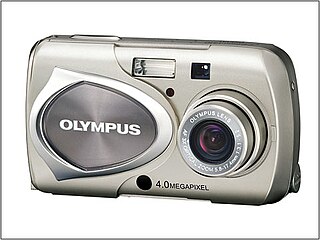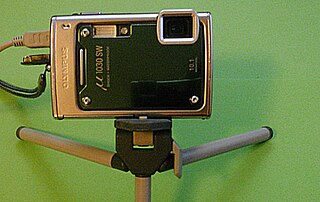Olympus Corporation is a Japanese manufacturer of optics and reprography products. Olympus was established on 12 October 1919, initially specializing in microscopes and thermometers. Olympus holds roughly a 70 percent share of the global endoscope market, estimated to be worth approximately US$2.5 billion. Its global headquarters are located in Shinjuku, Tokyo, Japan.

Mu is the twelfth letter of the Greek alphabet, representing the voiced bilabial nasal IPA: [m]. In the system of Greek numerals it has a value of 40. Mu was derived from the Egyptian hieroglyphic symbol for water, which had been simplified by the Phoenicians and named after their word for water, to become 𐤌 (mem). Letters that derive from mu include the Roman M and the Cyrillic М, though the lowercase resembles a small Latin U (μ).

The xD-Picture Card is an obsolete form of flash memory card, used in digital cameras made by Olympus, Fujifilm, and Kodak during the 2000s. The xD in the xD-Picture Card stands for eXtreme Digital.
U10D,S300D,u300D is a camera model designator for a digital cameras in the mju series manufactured by Olympus, which were sold by the names "μ-10 Digital" in Japan, "μ300 Digital" in Europe, and "Stylus 300 Digital" in North America. This text string is among the information embedded by the camera in the coding of the .JPEG image, mostly to help a computer find a compatible program to open it if it's not properly suffixed.
The Olympus mju is a series of compact film and digital cameras manufactured by Olympus.

The Olympus Stylus Epic, also known as the μ[mju:]-II in other parts of the world, is a 35mm compact camera. Introduced in 1997, the Olympus Stylus Epic followed a long line of fixed focal length, budget priced, consumer level, point and shoot cameras from Olympus that have tended to appeal to enthusiasts and professionals who want a camera small enough to fit in a pocket. It is much cheaper than most point and shoot cameras that are popular with enthusiasts.

The Olympus μ("mju") 700 — also known as the Olympus Stylus 710 in North America — is a 7.1 megapixel ultra-compact digital camera introduced by Olympus Corporation in 2006.
The Olympus μ("mju") 720 SW — also known as the Olympus Stylus 720 SW in North America — is a 7.1 megapixel ultra-compact salt-water submersible digital camera introduced by Olympus Corporation in 2006.

The Olympus Stylus 410, also known as μ("mju") 410D in some markets, is a 4.0 megapixel compact digital camera.

The Olympus SP-510UZ is a 7.1-megapixel bridge digital camera introduced by Olympus Corporation in 2006. It replaced the 6 megapixel SP-500UZ model that was launched in 2005. It was the last model of the SP-series that used a 10x optical zoom lens. It was also the last of the larger-sized 10x optical ultra zoom cameras to be made by Olympus, which had been part of the C-series before the SP-series was produced. The SP-510UZ model can be traced back to the C-2100 Ultra Zoom, which was launched back in 2000. The successor model to the SP-510UZ was the SP-550UZ. It used a longer 18x optical zoom lens. Today, the newest model in the Ultra Zoom camera line, the SP-590UZ, features a 26x optical zoom lens. In 2009, Olympus released a compact camera with a 10x optical zoom lens. However, it does not use the Ultra Zoom name nor is it a part of the SP-series line of cameras.

The Micro Four Thirds system is a standard released by Olympus and Panasonic in 2008, for the design and development of mirrorless interchangeable lens digital cameras, camcorders and lenses. Camera bodies are available from Blackmagic, DJI, JVC, Kodak, Olympus, Panasonic, Sharp, and Xiaomi. MFT lenses are produced by Cosina Voigtländer, DJI, Kowa, Kodak, Mitakon, Olympus, Panasonic, Samyang, Sharp, Sigma, SLR Magic, Tamron, Tokina, TTArtisan, Veydra, Xiaomi, Laowa, Yongnuo, Zonlai, Lensbaby, Kowa, Venus Optics and 7artisans amongst others.
The Olympus μ-9000 is the flagship model of Olympus' μ-Series line of point-and-shoot digital cameras. The μ Series consists of compact cameras characterized by small profiles, an optical zoom function, and a focus on stylish outward appearance.
Yoshihisa Maitani was a designer of cameras for the Japan-based camera manufacturer Olympus Corporation.

The Olympus PEN E-PL1 is a digital camera made by Olympus announced on 3 February 2010 and replaced in 2011. It was Olympus's third camera using the Micro Four Thirds system after the Olympus PEN E-P1 and Olympus PEN E-P2, and the first camera in Olympus' "PEN Lite" line.

The Olympus µ 1030 SW is 10.1 megapixel compact salt-water submersible digital camera introduced by Olympus Corporation in 2008. Shock-proof from heights of up to 2 m, waterproof up to a water pressure equivalent to 10 m depth, crushproof up to 100 kg, freezeproof up to -10 °C
The Olympus Stylus Tough TG-860 is a digital rugged compact camera announced by Olympus on February 5, 2015. It has built-in WiFi and GPS, and is waterproof to a depth of 15m, freezeproof to -10 degrees Celsius, crushproof to a force of 100 kg or 220 pounds. It's also shockproof against drops from up to 2.1m in height.
The Olympus Stylus SH-2 is a digital compact camera announced by Olympus Corporation on March 11, 2015. It differs from its predecessor, the Olympus Stylus SH-1, by the addition of raw format output, new nightscape modes and a Live Composite mode that helps with capturing star trails.
Zuiko is a brand of optical lenses made by Olympus Corporation that was used up to and into the Four Thirds system era. The name Zuiko (瑞光) means 'Light of the Gods', using a character from the Mizuho Optic Research Laboratory (瑞穂光学研究所), where the lens was developed, and a character from Takachiho Corporation (高千穂製作所), which would eventually become the Olympus Corporation.








